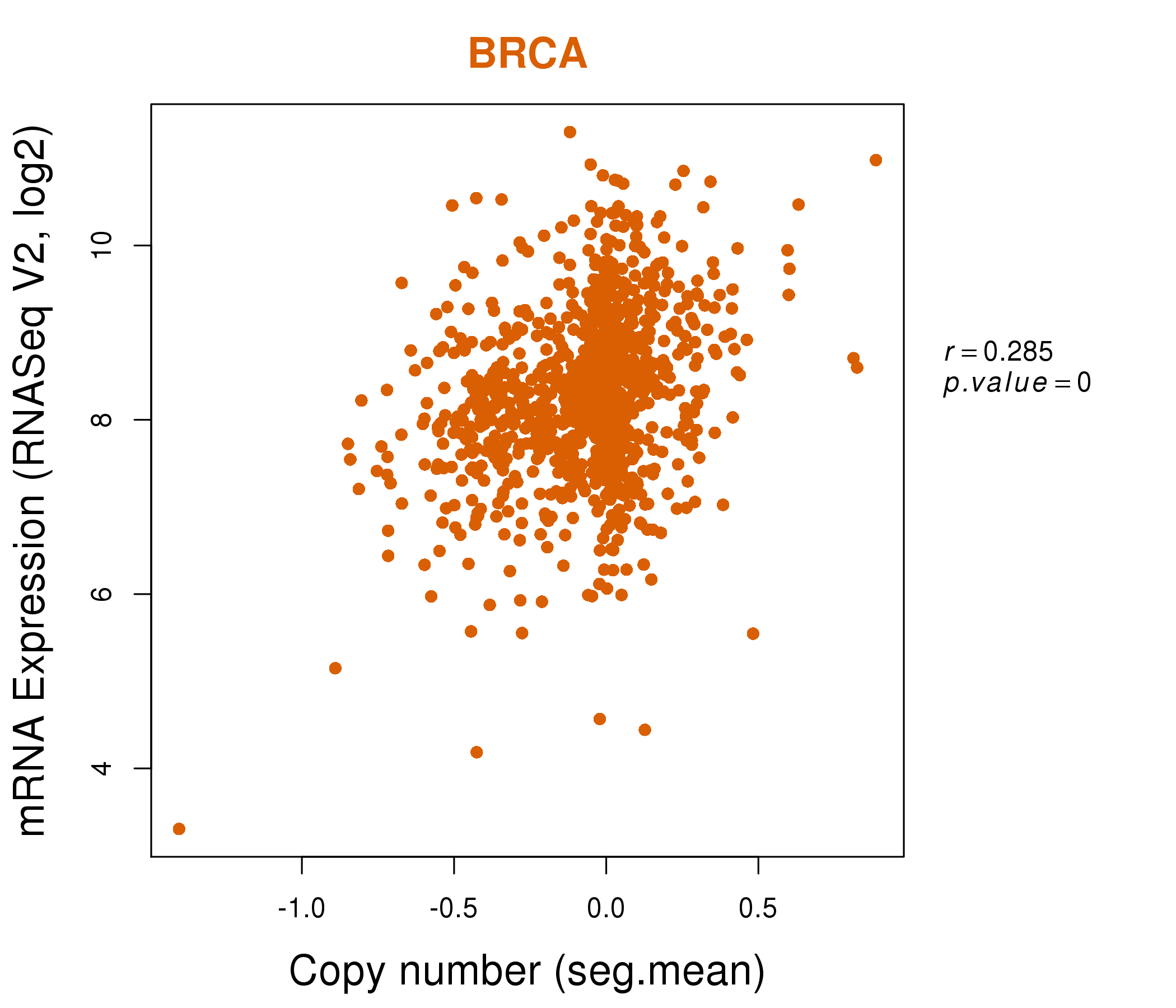|
|||||||||||||||||||||||||||||||||||||||||||||||||||||||||||||||||||||||||||||||||||||||||||||||||||||||||||||||||||||||||||||||||||||||||||||||||||||||||||||||||||||||||||||||||||||||||||||||||||||||||||||||||||||||||||||||||||||||||||||||||||||||||||||||||||||||||||||||||||||||||||||||||||||||||||||||||||||||||||||||||||||||||||||||||||||||||
| |
| Phenotypic Information (metabolism pathway, cancer, disease, phenome) |
| |
| |
| Gene-Gene Network Information: Co-Expression Network, Interacting Genes & KEGG |
| |
|
| Gene Summary for GPHN |
| Basic gene info. | Gene symbol | GPHN |
| Gene name | gephyrin | |
| Synonyms | GEPH|GPH|GPHRYN|HKPX1|MOCODC | |
| Cytomap | UCSC genome browser: 14q23.3 | |
| Genomic location | chr14 :66974124-67648525 | |
| Type of gene | protein-coding | |
| RefGenes | NM_001024218.1, NM_020806.4, | |
| Ensembl id | ENSG00000171723 | |
| Description | - | |
| Modification date | 20141219 | |
| dbXrefs | MIM : 603930 | |
| HGNC : HGNC | ||
| Ensembl : ENSG00000171723 | ||
| HPRD : 04893 | ||
| Vega : OTTHUMG00000029785 | ||
| Protein | UniProt: Q9NQX3 go to UniProt's Cross Reference DB Table | |
| Expression | CleanEX: HS_GPHN | |
| BioGPS: 10243 | ||
| Gene Expression Atlas: ENSG00000171723 | ||
| The Human Protein Atlas: ENSG00000171723 | ||
| Pathway | NCI Pathway Interaction Database: GPHN | |
| KEGG: GPHN | ||
| REACTOME: GPHN | ||
| ConsensusPathDB | ||
| Pathway Commons: GPHN | ||
| Metabolism | MetaCyc: GPHN | |
| HUMANCyc: GPHN | ||
| Regulation | Ensembl's Regulation: ENSG00000171723 | |
| miRBase: chr14 :66,974,124-67,648,525 | ||
| TargetScan: NM_001024218 | ||
| cisRED: ENSG00000171723 | ||
| Context | iHOP: GPHN | |
| cancer metabolism search in PubMed: GPHN | ||
| UCL Cancer Institute: GPHN | ||
| Assigned class in ccmGDB | B - This gene belongs to cancer gene. | |
| Top |
| Phenotypic Information for GPHN(metabolism pathway, cancer, disease, phenome) |
| Cancer | CGAP: GPHN |
| Familial Cancer Database: GPHN | |
| * This gene is included in those cancer gene databases. |
|
|
|
|
|
| . | |||||||||||||||||||||||||||||||||||||||||||||||||||||||||||||||||||||||||||||||||||||||||||||||||||||||||||||||||||||||||||||||||||||||||||||||||||||||||||||||||||||||||||||||||||||||||||||||||||||||||||||||||||||||||||||||||||||||||||||||||||||||||||||||||||||||||||||||||||||||||||||||||||||||||||||||||||||||||||||||||||||||||||||||||||
Oncogene 1 | Significant driver gene in | ||||||||||||||||||||||||||||||||||||||||||||||||||||||||||||||||||||||||||||||||||||||||||||||||||||||||||||||||||||||||||||||||||||||||||||||||||||||||||||||||||||||||||||||||||||||||||||||||||||||||||||||||||||||||||||||||||||||||||||||||||||||||||||||||||||||||||||||||||||||||||||||||||||||||||||||||||||||||||||||||||||||||||||||||||||||||
| cf) number; DB name 1 Oncogene; http://nar.oxfordjournals.org/content/35/suppl_1/D721.long, 2 Tumor Suppressor gene; https://bioinfo.uth.edu/TSGene/, 3 Cancer Gene Census; http://www.nature.com/nrc/journal/v4/n3/abs/nrc1299.html, 4 CancerGenes; http://nar.oxfordjournals.org/content/35/suppl_1/D721.long, 5 Network of Cancer Gene; http://ncg.kcl.ac.uk/index.php, 1Therapeutic Vulnerabilities in Cancer; http://cbio.mskcc.org/cancergenomics/statius/ |
| REACTOME_METABOLISM_OF_VITAMINS_AND_COFACTORS | |
| OMIM | 603930; gene. 615501; phenotype. |
| Orphanet | 308400; Sulfite oxidase deficiency due to molybdenum cofactor deficiency type C. 3197; Hereditary hyperekplexia. |
| Disease | KEGG Disease: GPHN |
| MedGen: GPHN (Human Medical Genetics with Condition) | |
| ClinVar: GPHN | |
| Phenotype | MGI: GPHN (International Mouse Phenotyping Consortium) |
| PhenomicDB: GPHN | |
| Mutations for GPHN |
| * Under tables are showing count per each tissue to give us broad intuition about tissue specific mutation patterns.You can go to the detailed page for each mutation database's web site. |
| - Statistics for Tissue and Mutation type | Top |
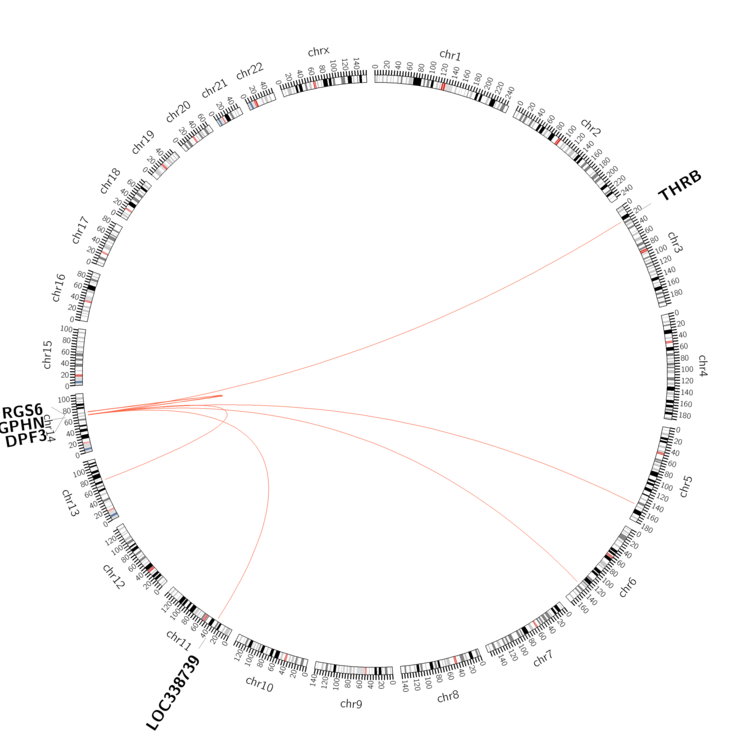 |
| - For Inter-chromosomal Variations |
| * Inter-chromosomal variantions includes 'interchromosomal amplicon to amplicon', 'interchromosomal amplicon to non-amplified dna', 'interchromosomal insertion', 'Interchromosomal unknown type'. |
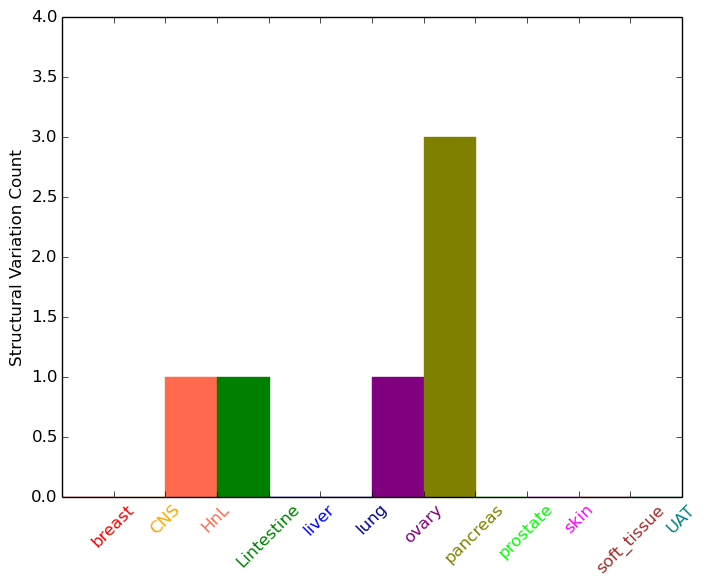 |
| - For Intra-chromosomal Variations |
| * Intra-chromosomal variantions includes 'intrachromosomal amplicon to amplicon', 'intrachromosomal amplicon to non-amplified dna', 'intrachromosomal deletion', 'intrachromosomal fold-back inversion', 'intrachromosomal inversion', 'intrachromosomal tandem duplication', 'Intrachromosomal unknown type', 'intrachromosomal with inverted orientation', 'intrachromosomal with non-inverted orientation'. |
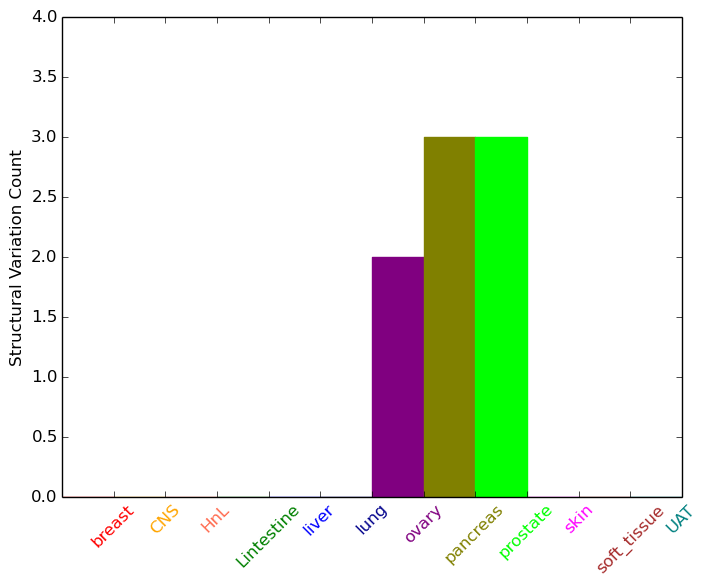 |
| Sample | Symbol_a | Chr_a | Start_a | End_a | Symbol_b | Chr_b | Start_b | End_b |
| ovary | GPHN | chr14 | 67283998 | 67284018 | GPHN | chr14 | 67284199 | 67284219 |
| ovary | GPHN | chr14 | 67482168 | 67482188 | GPHN | chr14 | 67482499 | 67482519 |
| pancreas | GPHN | chr14 | 67087992 | 67088192 | GPHN | chr14 | 67083708 | 67083908 |
| pancreas | GPHN | chr14 | 67588674 | 67588694 | GPHN | chr14 | 67623116 | 67623136 |
| pancreas | GPHN | chr14 | 67620693 | 67620713 | GPHN | chr14 | 67610533 | 67610553 |
| prostate | GPHN | chr14 | 66990562 | 66992562 | RGS6 | chr14 | 72644723 | 72646723 |
| prostate | GPHN | chr14 | 66990882 | 66992882 | RGS6 | chr14 | 72808787 | 72810787 |
| prostate | GPHN | chr14 | 67161914 | 67163914 | DPF3 | chr14 | 73349955 | 73351955 |
| cf) Tissue number; Tissue name (1;Breast, 2;Central_nervous_system, 3;Haematopoietic_and_lymphoid_tissue, 4;Large_intestine, 5;Liver, 6;Lung, 7;Ovary, 8;Pancreas, 9;Prostate, 10;Skin, 11;Soft_tissue, 12;Upper_aerodigestive_tract) |
| * From mRNA Sanger sequences, Chitars2.0 arranged chimeric transcripts. This table shows GPHN related fusion information. |
| ID | Head Gene | Tail Gene | Accession | Gene_a | qStart_a | qEnd_a | Chromosome_a | tStart_a | tEnd_a | Gene_a | qStart_a | qEnd_a | Chromosome_a | tStart_a | tEnd_a |
| DB087988 | USP6NL | 1 | 225 | 10 | 11639629 | 11653573 | GPHN | 225 | 462 | 14 | 67291192 | 67382765 | |
| BX509307 | GPHN | 1 | 88 | 14 | 67102484 | 67102571 | CCDC12 | 83 | 658 | 3 | 46982228 | 46982802 | |
| BE172739 | DNM1L | 23 | 143 | 12 | 32896833 | 32896951 | GPHN | 125 | 245 | 14 | 67625457 | 67625577 | |
| Top |
| Mutation type/ Tissue ID | brca | cns | cerv | endome | haematopo | kidn | Lintest | liver | lung | ns | ovary | pancre | prost | skin | stoma | thyro | urina | |||
| Total # sample | 5 | 2 | 1 | 1 | 1 | 1 | 2 | |||||||||||||
| GAIN (# sample) | 1 | 1 | 1 | |||||||||||||||||
| LOSS (# sample) | 4 | 1 | 1 | 1 | 1 | 1 | 1 |
| cf) Tissue ID; Tissue type (1; Breast, 2; Central_nervous_system, 3; Cervix, 4; Endometrium, 5; Haematopoietic_and_lymphoid_tissue, 6; Kidney, 7; Large_intestine, 8; Liver, 9; Lung, 10; NS, 11; Ovary, 12; Pancreas, 13; Prostate, 14; Skin, 15; Stomach, 16; Thyroid, 17; Urinary_tract) |
| Top |
|
 |
| Top |
| Stat. for Non-Synonymous SNVs (# total SNVs=11) | (# total SNVs=0) |
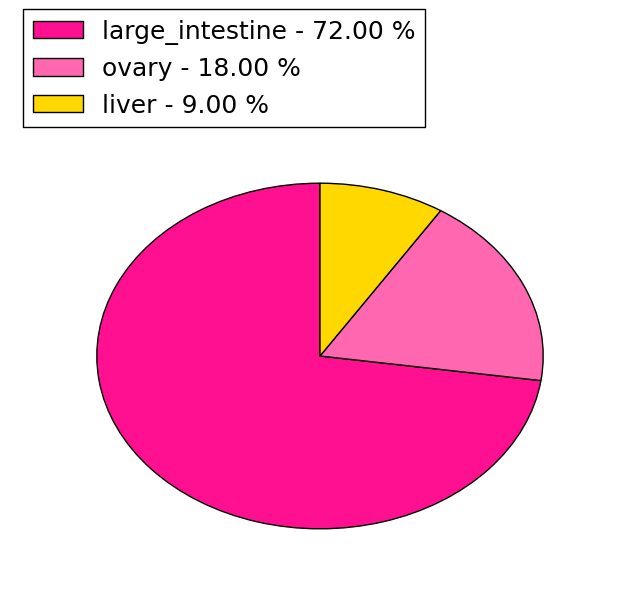 | |
(# total SNVs=0) | (# total SNVs=0) |
| Top |
| * When you move the cursor on each content, you can see more deailed mutation information on the Tooltip. Those are primary_site,primary_histology,mutation(aa),pubmedID. |
| GRCh37 position | Mutation(aa) | Unique sampleID count |
| chr14:67578599-67578599 | p.R479* | 2 |
| chr14:67589031-67589031 | p.T562S | 1 |
| chr14:67626169-67626169 | p.A625V | 1 |
| chr14:67631930-67631930 | p.I654M | 1 |
| chr14:67635728-67635728 | p.P685L | 1 |
| chr14:67147816-67147816 | p.? | 1 |
| chr14:67346678-67346678 | p.R106W | 1 |
| chr14:67346679-67346679 | p.R106Q | 1 |
| chr14:67389434-67389434 | p.R170C | 1 |
| chr14:67389594-67389594 | p.G223A | 1 |
| Top |
|
 |
| Point Mutation/ Tissue ID | 1 | 2 | 3 | 4 | 5 | 6 | 7 | 8 | 9 | 10 | 11 | 12 | 13 | 14 | 15 | 16 | 17 | 18 | 19 | 20 |
| # sample | 1 | 3 | 15 | 1 | 4 | 1 | 3 | 1 | 2 | 9 | 8 | 11 | ||||||||
| # mutation | 1 | 3 | 14 | 1 | 4 | 1 | 3 | 1 | 2 | 11 | 10 | 20 | ||||||||
| nonsynonymous SNV | 1 | 2 | 12 | 1 | 3 | 1 | 3 | 2 | 8 | 10 | 16 | |||||||||
| synonymous SNV | 1 | 2 | 1 | 1 | 3 | 4 |
| cf) Tissue ID; Tissue type (1; BLCA[Bladder Urothelial Carcinoma], 2; BRCA[Breast invasive carcinoma], 3; CESC[Cervical squamous cell carcinoma and endocervical adenocarcinoma], 4; COAD[Colon adenocarcinoma], 5; GBM[Glioblastoma multiforme], 6; Glioma Low Grade, 7; HNSC[Head and Neck squamous cell carcinoma], 8; KICH[Kidney Chromophobe], 9; KIRC[Kidney renal clear cell carcinoma], 10; KIRP[Kidney renal papillary cell carcinoma], 11; LAML[Acute Myeloid Leukemia], 12; LUAD[Lung adenocarcinoma], 13; LUSC[Lung squamous cell carcinoma], 14; OV[Ovarian serous cystadenocarcinoma ], 15; PAAD[Pancreatic adenocarcinoma], 16; PRAD[Prostate adenocarcinoma], 17; SKCM[Skin Cutaneous Melanoma], 18:STAD[Stomach adenocarcinoma], 19:THCA[Thyroid carcinoma], 20:UCEC[Uterine Corpus Endometrial Carcinoma]) |
| Top |
| * We represented just top 10 SNVs. When you move the cursor on each content, you can see more deailed mutation information on the Tooltip. Those are primary_site, primary_histology, mutation(aa), pubmedID. |
| Genomic Position | Mutation(aa) | Unique sampleID count |
| chr14:67626169 | p.R527C,GPHN | 3 |
| chr14:67589024 | p.A592V,GPHN | 3 |
| chr14:67525490 | p.I344I,GPHN | 2 |
| chr14:67631930 | p.R387C,GPHN | 2 |
| chr14:67567593 | p.I621M,GPHN | 2 |
| chr14:67389564 | p.T139T,GPHN | 1 |
| chr14:67589068 | p.S270L,GPHN | 1 |
| chr14:67431987 | p.L484F,GPHN | 1 |
| chr14:67635728 | p.P652L,GPHN | 1 |
| chr14:67647646 | p.D167H,GPHN | 1 |
| * Copy number data were extracted from TCGA using R package TCGA-Assembler. The URLs of all public data files on TCGA DCC data server were gathered on Jan-05-2015. Function ProcessCNAData in TCGA-Assembler package was used to obtain gene-level copy number value which is calculated as the average copy number of the genomic region of a gene. |
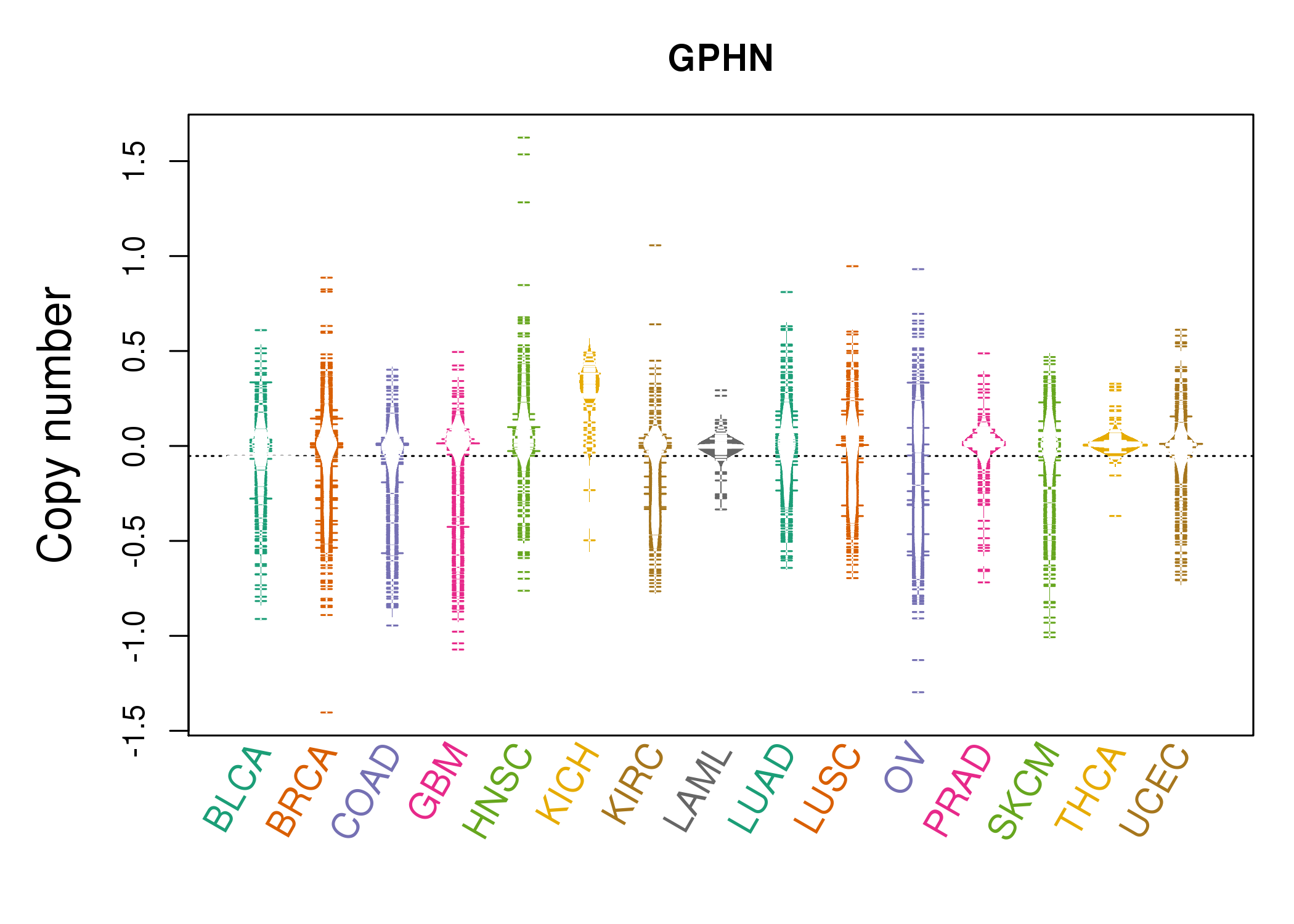 |
| cf) Tissue ID[Tissue type]: BLCA[Bladder Urothelial Carcinoma], BRCA[Breast invasive carcinoma], CESC[Cervical squamous cell carcinoma and endocervical adenocarcinoma], COAD[Colon adenocarcinoma], GBM[Glioblastoma multiforme], Glioma Low Grade, HNSC[Head and Neck squamous cell carcinoma], KICH[Kidney Chromophobe], KIRC[Kidney renal clear cell carcinoma], KIRP[Kidney renal papillary cell carcinoma], LAML[Acute Myeloid Leukemia], LUAD[Lung adenocarcinoma], LUSC[Lung squamous cell carcinoma], OV[Ovarian serous cystadenocarcinoma ], PAAD[Pancreatic adenocarcinoma], PRAD[Prostate adenocarcinoma], SKCM[Skin Cutaneous Melanoma], STAD[Stomach adenocarcinoma], THCA[Thyroid carcinoma], UCEC[Uterine Corpus Endometrial Carcinoma] |
| Top |
| Gene Expression for GPHN |
| * CCLE gene expression data were extracted from CCLE_Expression_Entrez_2012-10-18.res: Gene-centric RMA-normalized mRNA expression data. |
 |
| * Normalized gene expression data of RNASeqV2 was extracted from TCGA using R package TCGA-Assembler. The URLs of all public data files on TCGA DCC data server were gathered at Jan-05-2015. Only eight cancer types have enough normal control samples for differential expression analysis. (t test, adjusted p<0.05 (using Benjamini-Hochberg FDR)) |
 |
| Top |
| * This plots show the correlation between CNV and gene expression. |
: Open all plots for all cancer types
 |
|
 |
|
| Top |
| Gene-Gene Network Information |
| * Co-Expression network figures were drawn using R package igraph. Only the top 20 genes with the highest correlations were shown. Red circle: input gene, orange circle: cell metabolism gene, sky circle: other gene |
: Open all plots for all cancer types
 |
| ||||
| ATP6V1C1,DHRS4-AS1,LINC00238,C8orf37,DNAL1,EARS2,EBAG9, EXD2,FLNB,GPHN,MAPT,MBLAC2,OCIAD1,PARD6B, RAD17,SLC39A9,STAU2,TMEM128,TRPS1,UBXN2B,WWP1 | ABCB7,AGPAT9,ALDH1L1,AMBN,BMP3,C17orf53,IZUMO4, CTH,EYA1,GLUL,GMCL1,GPD1L,GPHN,HADH, MOCS1,NTSR2,PMM1,PXMP2,RASL10B,TCEB3,USP30 | ||||
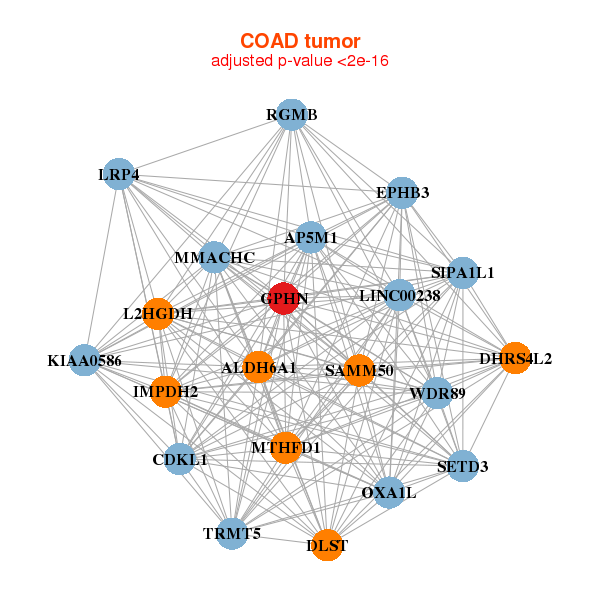 |
| ||||
| ALDH6A1,LINC00238,CDKL1,DHRS4L2,DLST,EPHB3,GPHN, IMPDH2,KIAA0586,L2HGDH,LRP4,MMACHC,MTHFD1,AP5M1, OXA1L,RGMB,SAMM50,SETD3,SIPA1L1,TRMT5,WDR89 | ANAPC1,AQR,ATIC,PROSER1,CBX5,CCDC15,DCAF7, EXOSC10,GANAB,GPHN,INCENP,INTS9,FOCAD,NCAPD2, PAXIP1,PTK7,SND1,SPTLC2,SSRP1,TOP2A,VPRBP |
| * Co-Expression network figures were drawn using R package igraph. Only the top 20 genes with the highest correlations were shown. Red circle: input gene, orange circle: cell metabolism gene, sky circle: other gene |
: Open all plots for all cancer types
| Top |
: Open all interacting genes' information including KEGG pathway for all interacting genes from DAVID
| Top |
| Pharmacological Information for GPHN |
| DB Category | DB Name | DB's ID and Url link |
| Organism-specific databases | PharmGKB | PA28840; -. |
| Organism-specific databases | CTD | 10243; -. |
| * Gene Centered Interaction Network. |
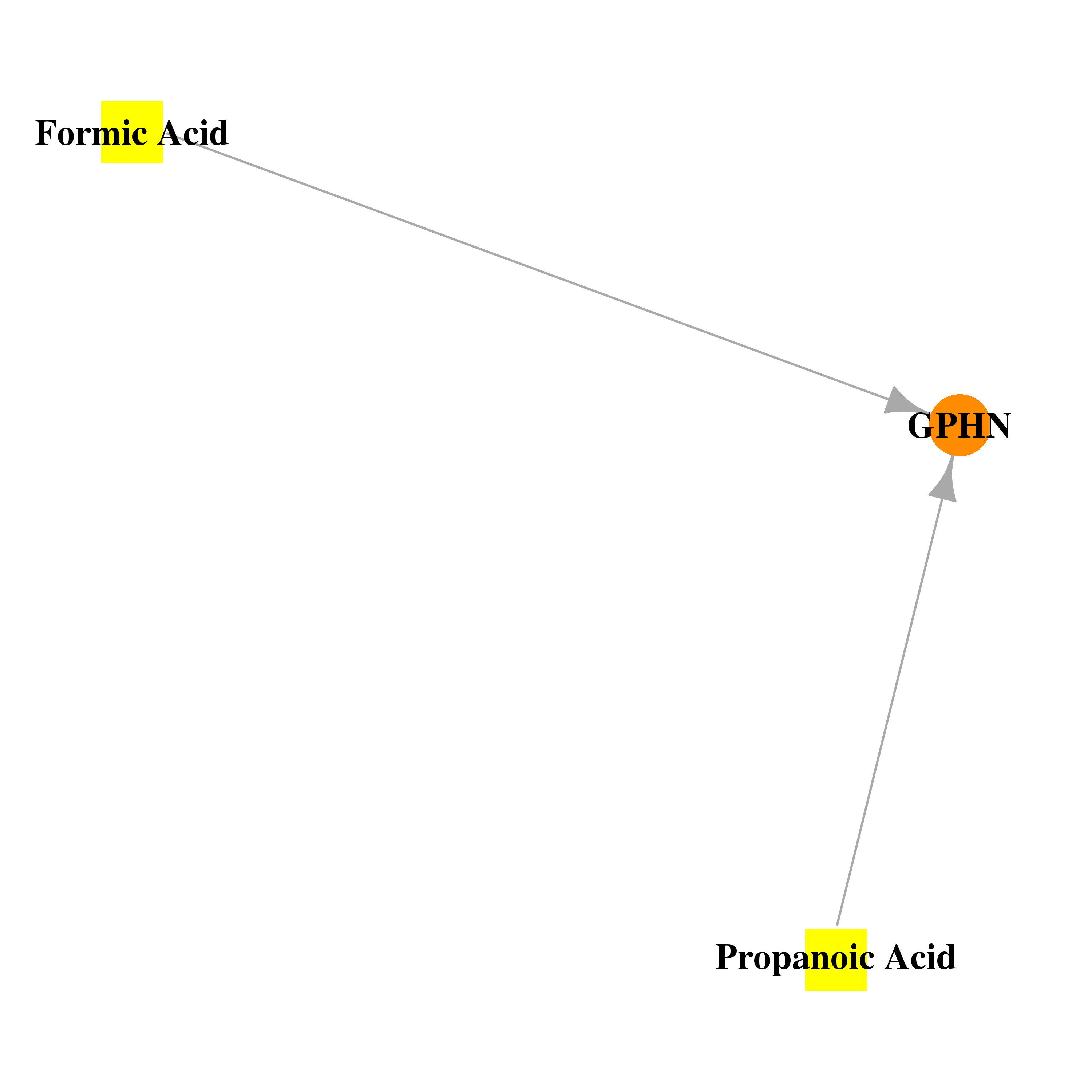 |
| * Drug Centered Interaction Network. |
| DrugBank ID | Target Name | Drug Groups | Generic Name | Drug Centered Network | Drug Structure |
| DB01942 | gephyrin | experimental | Formic Acid |  |  |
| DB03766 | gephyrin | experimental | Propanoic Acid |  |  |
| Top |
| Cross referenced IDs for GPHN |
| * We obtained these cross-references from Uniprot database. It covers 150 different DBs, 18 categories. http://www.uniprot.org/help/cross_references_section |
: Open all cross reference information
|
Copyright © 2016-Present - The Univsersity of Texas Health Science Center at Houston @ |






